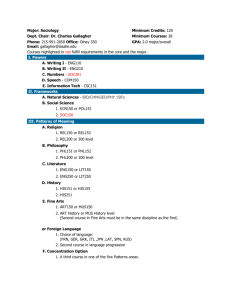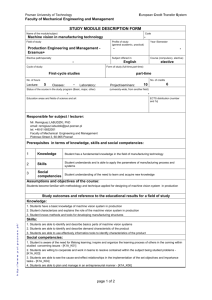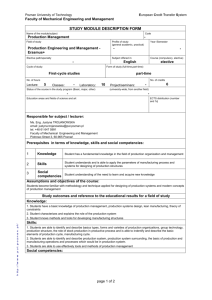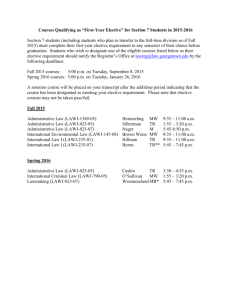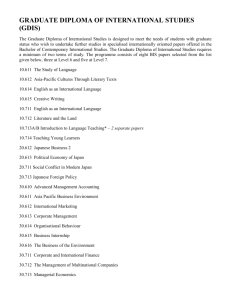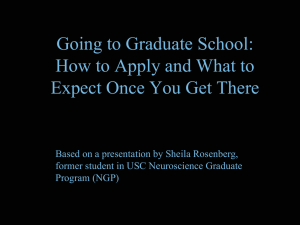Nagoya - BI Norwegian Business School
advertisement
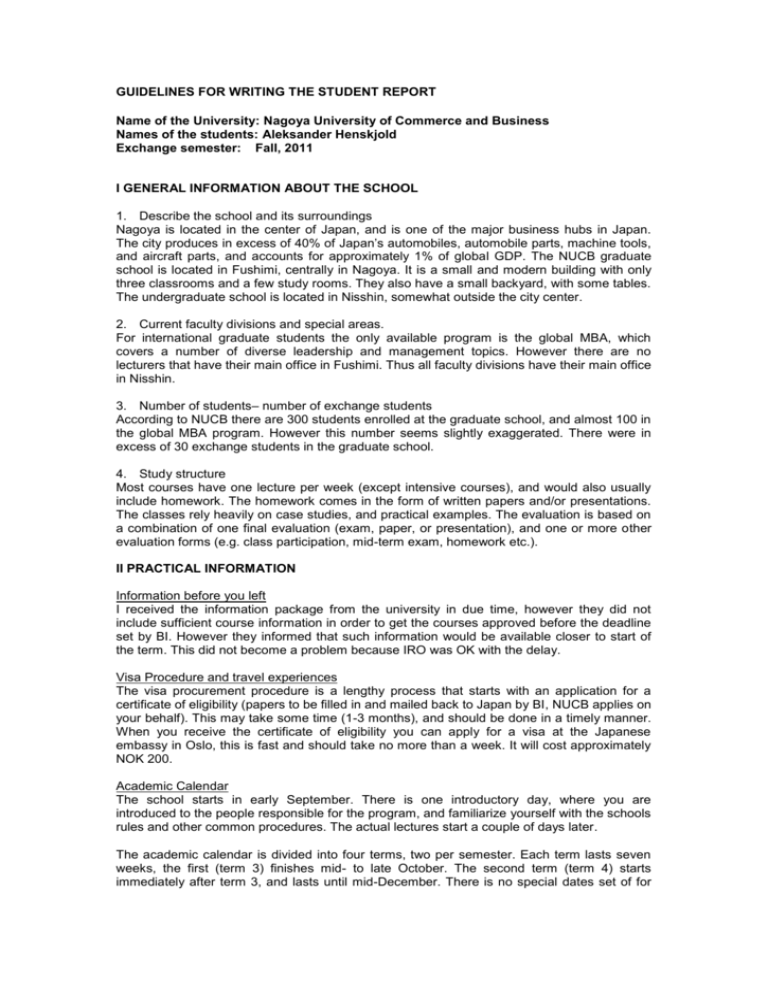
GUIDELINES FOR WRITING THE STUDENT REPORT Name of the University: Nagoya University of Commerce and Business Names of the students: Aleksander Henskjold Exchange semester: Fall, 2011 I GENERAL INFORMATION ABOUT THE SCHOOL 1. Describe the school and its surroundings Nagoya is located in the center of Japan, and is one of the major business hubs in Japan. The city produces in excess of 40% of Japan’s automobiles, automobile parts, machine tools, and aircraft parts, and accounts for approximately 1% of global GDP. The NUCB graduate school is located in Fushimi, centrally in Nagoya. It is a small and modern building with only three classrooms and a few study rooms. They also have a small backyard, with some tables. The undergraduate school is located in Nisshin, somewhat outside the city center. 2. Current faculty divisions and special areas. For international graduate students the only available program is the global MBA, which covers a number of diverse leadership and management topics. However there are no lecturers that have their main office in Fushimi. Thus all faculty divisions have their main office in Nisshin. 3. Number of students– number of exchange students According to NUCB there are 300 students enrolled at the graduate school, and almost 100 in the global MBA program. However this number seems slightly exaggerated. There were in excess of 30 exchange students in the graduate school. 4. Study structure Most courses have one lecture per week (except intensive courses), and would also usually include homework. The homework comes in the form of written papers and/or presentations. The classes rely heavily on case studies, and practical examples. The evaluation is based on a combination of one final evaluation (exam, paper, or presentation), and one or more other evaluation forms (e.g. class participation, mid-term exam, homework etc.). II PRACTICAL INFORMATION Information before you left I received the information package from the university in due time, however they did not include sufficient course information in order to get the courses approved before the deadline set by BI. However they informed that such information would be available closer to start of the term. This did not become a problem because IRO was OK with the delay. Visa Procedure and travel experiences The visa procurement procedure is a lengthy process that starts with an application for a certificate of eligibility (papers to be filled in and mailed back to Japan by BI, NUCB applies on your behalf). This may take some time (1-3 months), and should be done in a timely manner. When you receive the certificate of eligibility you can apply for a visa at the Japanese embassy in Oslo, this is fast and should take no more than a week. It will cost approximately NOK 200. Academic Calendar The school starts in early September. There is one introductory day, where you are introduced to the people responsible for the program, and familiarize yourself with the schools rules and other common procedures. The actual lectures start a couple of days later. The academic calendar is divided into four terms, two per semester. Each term lasts seven weeks, the first (term 3) finishes mid- to late October. The second term (term 4) starts immediately after term 3, and lasts until mid-December. There is no special dates set of for exams, they are usually held in last class of the course, however in some courses there might be final papers due later than last class. Reception The reception was professional and well organized. The first day we were taken to, and showed around, our dormitory. The next day there was an introductory day at the school. In addition to the administration staff there was also a current student present to guide us through how to use the schools IT resources (Japanese interface and menus by default). It was all over fairly quickly (a couple of hours), mainly due to the fact that there are only a few foreign exchange students. Housing The school provides housing at one of their two dormitories. One is located in Chiyoda the other in Higashiyama. The Chiyoda residence is less expensive and closer to school than the Higashiyama residence, however the Higashiyama residence is bigger and more modern, they offer breakfast 5 days a week, housekeeping once a week, and electric bikes included in the rent. The Higashiyama residence also offers a common area and a common kitchen, and they have by FAR the most comfortable beds. I was assigned to the Higashiyama residence, without being offered a choice, however I assume that it would be possible to request staying in Chiyoda. Costs Rent is paid in advance for the exchange students (somewhat in excess of NOK 20’000 for the entire period). Japan is fairly expensive; however in general things are slightly less expensive than Norway; however chances are you will find yourself spending at least as much as in Norway. Food is one of the things you will be able to find cheaper, and eating out can cost from 500 yen (approximately NOK 37), however more commonly you would end up closer to 1000 yen. If you are getting quality meat or sushi you must expect to pay a lot more. Your traveling expenses will depend on where in Nagoya you live, and of course how much you would like to travel. A commuter pass from Higashiyama to the graduate school campus will cost approximately 16’000 yen for three months. So it is slightly more expensive than in Oslo, also if you travel on further, or on a different subway-line, you will have to pay extra (Tip: buy the commuter-pass that is valid from Higashiyama to Nagoya station, it is the same price as to the school, but you can travel one stop further). Nightlife is generally cheaper than Oslo; however, beer is relatively expensive, and will usually cost from 500 yen and upward. Tip: Do not buy books before first class, some lecturers will not use the books, or they will distribute printed material. The International Office Apparently, there is an international office at Nisshin campus; however, as a graduate student you will mostly deal with the office in Fushimi. This is also where you will find the person who is responsible for the incoming graduate exchange students. There are people there as long as the school is open, and they will usually do their best to help you with any problems. Nevertheless, this is Japan so complaining or raising an issue can sometimes be difficult. I did not have any trouble with the office. Social Activities The global MBA program is very small, thus ensuring that you would usually know everyone in your classes. I had a good relationship to the other students, which mostly consists of exchange students or double degree students, in addition to some fulltime students (mainly foreigners). At the graduate school, there are no other organized activities than a couple of field trips for the exchange students, visiting well-known producers and manufacturers. When I was there, they arranged trips to Toyota and a Sake and vinegar producer. Due to the size and number of students, the atmosphere was usually relaxed and good. Culture and Language There were no major language difficulties at school. There was always someone with a high level of English available in the office, and most of the students were proficient in English. There was only a few Japanese in my classes, and they were not the most typical Japanese people. However as long as you went out of the confinement of the school you would struggle much more with the language and experience more Japanese culture. You should have many opportunities to see the country and experience the culture, either in Nagoya or by traveling around the country. Cultural and Social Effects from the Exchange Experience As always, spending time in a foreign country will enhance your cultural understanding, which is never a bad idea. As for the Japanese culture you will be exposed to, and learn from, a culture that is vastly different from the Norwegian and western culture. III ACADEMIC INFORMATION The Teaching situation All courses was taught in English, however some of the Japanese professors did not have such a high level of English, making some courses more difficult to follow. Nevertheless, the courses at NUCB are generally at a much easier level than at BI with respect to theory. This is an MBA program that is aimed at people with some work experience, and many of the students have not been studying for many years. Thus the teaching generally relies on practical examples and cases, only using theory where needed. Most courses include a relatively large number of cases, which is usually worked on in teams. Often a large part of the lectures is set aside for group presentation, group discussions, or class discussions. We would usually always receive homework (often in the form of case analysis individually or in groups), making the workload somewhat heavy. However because the material is not so theoretically heavy it is possible to get by with less work than at BI, depending on how much efforts you put into each subject. The students generally have a much closer relationship with their lecturers at NUCB than at BI, some professors might also invite students to eat and drink with them after class. The relationship between the students in the classroom is generally very relaxed; in some smaller classes, the tone and feel in the lecture might even seem quite informal. Required Literature All required literature is in English. Most of which is distributed in class, or casebooks bought in the school office. The theoretical literature is generally meant to give a broad overview of the topic, and how to apply it in real life. The exams and other assignments are generally based on what has been covered in lectures, however it is still wise to review the literature beforehand. Exams The final exam was usually in the form of a final paper, which should cover all or most of the topics we had been through, usually applied to a case. However, some final exams were given as regular written exams, with theoretical and practical questions, and some used final presentation. Throughout the courses, there were also many small quizzes or medium sized mid-terms. These would be easier and less complex, usually just multiple choice, or explanations of theoretical expressions. Passing a course is generally not difficult, you should have covered most topics thoroughly in class and therefor it will be less reading than for an exam at BI. Other The main library is in Nisshin, which is far away. Books can be ordered from Nisshin to Fushimi in a day or two. The Fushimi campus is modern and well equipped with Mac computers and study rooms. There was never any problem finding a seat at school and usually not at a computer either. The school also offers wireless network all over. The school uses Blackboard as well as another webpage to distribute material and information (such as grades and other important announcements). Description of Courses Course name: Prereq. Exam Major at BI Approved as Strategic Management None Report Finance Elective Medium/heavy workload, weekly reports, student presentations, large final report Practical course, casework, some theory Difficulty: Medium Intercultural Business None Written Finance Elective Communication Heavy workload, weekly assignments, both final report and final written exam, oral presentation functions as midterm exam Practical and theoretical teaching intertwined Difficulty: Medium/hard Consumer Behavior None Report Finance Elective Medium/heavy workload, large weekly presentations, midterm exam (multiple choice and written) Practical course, few guidelines given by professor Difficulty: Easy/medium Labor Market None Presentation Finance Analysis Light/medium workload, weekly tests and/or hand-ins Theoretical course Difficulty: Easy Elective Human Resource None Written Finance Elective Management Light/medium workload, some presentations, multiple choice midterm exam Theoretical and practical course Difficulty: Easy Elementary Japanese I None Written Finance Light/medium workload, weekly tests, written midterm exam Mainly focuses on survival Japanese and set phrases Difficulty: Easy Elective International None Report Finance Elective Entrepreneurship Light workload, weekly presentations Practical course, case discussions, strong emphasis on class participation Difficulty: Medium Quality Control and None Presentation Finance Elective Assurance Light workload, intensive course that runs over 4 lectures, no intermediate evaluation Theoretical teaching with practical implication Difficulty: Easy Managerial Accounting None Report Finance Elective Medium workload, weekly tests and hand-ins Theoretical course Difficulty: Easy ………………………………………………………………………………………….. Name and e-mail: Aleksander Henskjold aleksander.b.henskjold@student.bi.no
